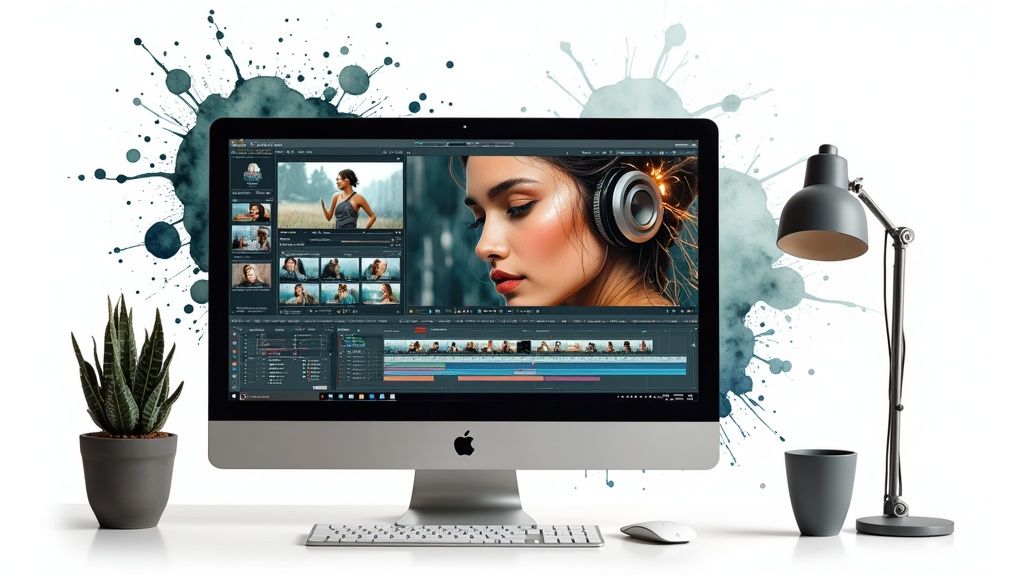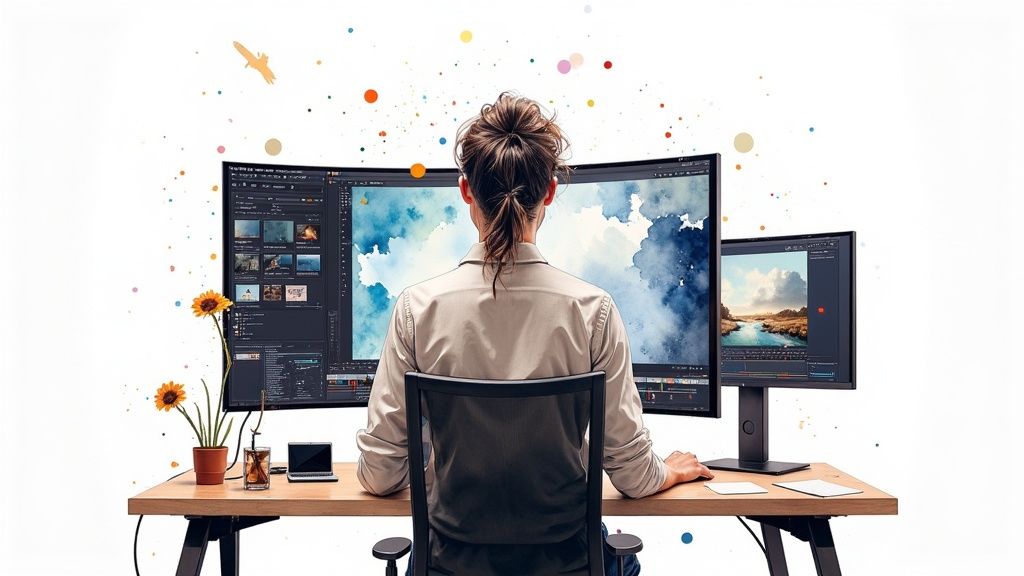How AI in Video is Reshaping Production Reality

AI is fundamentally changing how videos are created, from planning through post-production. What was once a manual, time-intensive process is now being enhanced by AI tools that handle technical tasks while letting creators focus on storytelling and artistry.
Making Video Production More Efficient
AI brings major improvements to video production workflows. Tasks that used to require hours of human effort - like editing, transcription, and scriptwriting - can now be automated. AI tools can generate subtitles, create transcripts, and assemble initial video cuts based on set parameters. This frees up editors and producers to focus on refining the story and enhancing the visual experience.
The impact on time and cost savings is significant. Companies using AI video tools are seeing up to 80% reductions in production time and expenses compared to traditional methods. Learn more about the impact in these Video Content Statistics.
Better Video Quality and Reach
AI improves both technical quality and accessibility. Smart algorithms can automatically optimize lighting, colors, and audio while removing unwanted noise - helping create polished videos even from basic source footage. AI-powered caption and translation features also make videos accessible to wider audiences globally. For more details, see How AI Enhances Video Quality.
Data-Driven Video Creation
AI analyzes viewer data to help creators make smarter decisions. By studying which video topics, styles and formats perform best with target audiences, AI provides insights to optimize future content. This means videos can be tailored for maximum engagement and reach based on real performance data rather than guesswork.
The Road Ahead for AI Video
New AI video capabilities continue emerging rapidly. As the technology grows more sophisticated, we'll see even more possibilities for video creation and consumption. From automated editing to personalized recommendations, AI is opening up exciting opportunities for creators to tell stories in fresh ways. The future of video production will be shaped by finding the right balance between AI assistance and human creativity.
Smart Marketing: AI Video Tools That Drive Results
In 2024, AI is fundamentally changing how brands create and distribute video marketing content. From custom videos to data-driven testing, AI tools help marketers develop campaigns that truly connect with viewers.
Personalized Video Experiences With AI
By analyzing viewer data like demographics and watching habits, AI helps create customized video content for each person. This targeted approach feels more like a one-on-one conversation than a generic broadcast, leading to better engagement and stronger audience connections.
Automating A/B Testing for Video Campaigns
Testing different video versions used to require lots of manual work and time. Now AI can automatically test variations and track metrics like click-through rates and watch time. This helps marketers quickly see which videos perform best with their audience and adjust accordingly.
AI-Powered Creative Enhancement for Videos
AI supports the creative side of video production too. Tools can help brainstorm scripts and video concepts while analyzing engagement data to improve future content. This combo of AI assistance and data insights helps marketers make smarter choices. Learn more about using AI for video: How to Master AI Video Editing for Social Media.
Balancing Automation and Authenticity in Video Marketing
Recent data shows that 18% of brands now use AI video tools, with 59% using AI for captions and 50% for scripts and ideation. See detailed stats here. While AI brings powerful capabilities, keeping your brand's authentic voice is crucial. The key is finding the right mix - too much automation can make content feel generic and impersonal.
AI Video Marketing Tools and Their Benefits
Here's a look at how brands are putting AI video tools to work:
| Application | Percentage of Brands | Key Benefits |
|---|---|---|
| Generating Captions | 59% | Increased accessibility, improved SEO |
| Generating Scripts and Ideas | 50% | Enhanced creativity, streamlined workflow |
| Personalized Video Content | Emerging Trend | Deeper engagement, stronger connections |
| Automated A/B Testing | Emerging Trend | Data-driven optimization, improved campaign performance |
By combining AI-powered insights with compelling storytelling, marketers can create videos that truly resonate with their target audience. The right AI tools help brands share their message more effectively while maintaining authentic connections with viewers.
Beyond Marketing: AI Video in Enterprise Solutions

While AI video technology has made major strides in marketing, its impact reaches much further into core business operations. Companies across industries are finding practical ways to integrate AI-powered video systems into their daily workflows to solve real business challenges.
AI-Driven Quality Control
AI excels at quality control through automated visual inspection. Advanced algorithms analyze video feeds from production lines in real-time, catching defects that human inspectors might miss. For example, manufacturing facilities use AI systems to spot tiny scratches and imperfections, resulting in higher product quality and reduced waste. This leads to significant cost savings while building customer confidence.
Enhancing Safety and Security With AI Video
AI video systems help create safer workplaces through continuous monitoring. The technology can instantly identify safety violations like missing protective equipment and alert supervisors. In security applications, AI cameras detect suspicious activities in restricted areas and trigger rapid response protocols. The systems also analyze traffic patterns to reduce congestion and prevent accidents.
Optimizing Processes Through AI-Powered Video Analysis
AI video analytics reveals opportunities to improve complex operations. By studying video data, businesses spot bottlenecks and inefficiencies across their facilities. Common applications include:
- Tracking inventory movement in warehouses
- Monitoring patient care activities in hospitals
- Predicting equipment maintenance needs by analyzing machinery footage
These insights allow companies to make data-driven improvements. The technology's role continues expanding in manufacturing, where AI enhances machine vision and robotic systems. Learn more about industrial AI applications here.
Real-World Examples of AI Video in Enterprise
Major companies are seeing measurable results from AI video technology. Manufacturing plants report increased production efficiency and lower defect rates using AI inspection systems. Energy companies use video analytics to monitor infrastructure and quickly identify potential problems like pipeline leaks. These successes demonstrate how AI video delivers practical value through improved operations, enhanced safety, and reduced costs. As the technology advances, more businesses are adopting AI video solutions to sharpen their competitive edge.
Investing in the AI Video Revolution
The AI video industry is experiencing major growth and creating new opportunities for businesses and investors. To succeed in this space, companies need to look beyond flashy headlines and carefully evaluate where real value can be found. Strategic assessment of market dynamics and promising applications is essential.
Key Drivers of Growth in AI Video
Several important trends are pushing the AI video market forward. First, there's increasing demand for personalized video content, which is driving development of AI tools that can automate and customize video creation. This enables deeper audience connections and better engagement. Additionally, improvements in AI algorithms now allow for higher quality video production with less manual work, making professional video creation accessible to organizations of all sizes.
Emerging Opportunities in the AI Video Market
New and exciting possibilities are emerging in the AI video space. Synthetic media and virtual production technologies use AI to generate realistic visuals and environments - creating fresh opportunities for filmmakers, advertisers and other creative professionals. We're also seeing growing adoption of AI-powered video analytics platforms that help businesses understand viewer behavior and optimize their content strategy based on data.
The growth trajectory is impressive. Market research shows the global AI industry, including video applications, is on track to reach $747.92 billion by 2025, growing at 20.4% annually. Learn more about the latest AI market statistics here. These numbers highlight AI's expanding influence across industries.
Positioning Your Organization for Success
To thrive in the AI video landscape, businesses need a clear strategy. Start by identifying AI tools and platforms that match your specific objectives - whether that's streamlining video editing, creating personalized content, or gaining viewer insights. Carefully evaluate vendors and understand what different technologies can and cannot do. Make sure to invest in training so your team can effectively use these tools. A thoughtful, proactive approach will help organizations capture the full benefits of AI video technology.
Your AI Video Implementation Blueprint

Adding AI tools to your video production requires careful planning. Here's a practical guide to help you pick the right tools, set them up effectively, and track their impact on your goals.
Selecting the Right AI Video Tools
When choosing AI video tools, focus on what matters most for your needs:
- Core video objectives - Are you creating marketing videos, internal communications, or something else? Different tools excel in different areas. For example, Aeon helps publishers turn written content into engaging videos quickly.
- Budget constraints - Options range from free basic tools to premium enterprise solutions
- Team skills - Some tools need more technical knowledge than others. Look for user-friendly options if your team is just starting out
- System connections - Check if tools can work smoothly with your current software
For example, if you want to make personalized marketing videos, focus on AI tools that handle audience targeting and dynamic content. But for basic tasks like adding captions, simpler tools work fine.
Effective Integration of AI Video Tools
Good integration needs proper setup and execution:
- Test with a small project first - Try AI tools on a limited scale to work out any issues before full deployment
- Train your team well - Make sure everyone knows how to use the new tools. Create clear guides and hold training sessions
- Set clear success measures - Pick specific metrics like video views, engagement, or time saved to track results
- Keep improving - Watch your results and adjust as needed. Stay up to date with new AI features that could help
Good communication with your team is key. Explain how AI tools will help their work and address any worries they have. This helps everyone adapt to the changes more easily.
Measuring the Impact of AI in Video
Track these key areas to see how well your AI tools are working:
- Production efficiency - Measure time and money saved through automation. Track video completion times and cost reductions
- Viewer response - Look at video views, watch duration, and social sharing to see if AI-made videos connect with audiences
- Business results - Link your AI video work to bigger goals. For marketing videos, check how they affect lead generation
Using data helps show which AI tools give the best results and where you can make improvements.
AI Video Tool Selection Guide
Here's a comparison of different AI video tools to help you choose:
| Tool Type | Key Features | Best For | Cost Range |
|---|---|---|---|
| Automated Video Editing | Smart trimming, scene picking, basic effects | Content creators wanting faster workflow | Free - $50/month |
| Personalized Video Creation | Custom content based on viewer data | Marketing teams doing targeted campaigns | $50 - $200/month |
| Video Analytics Platforms | Viewer insights and performance tracking | Teams focused on data-driven content | $100 - $500+/month |
| AI-Powered Scriptwriting | Story ideas and script automation | Writers needing creative assistance | Free - $100/month |
Following this guide and adapting it to your needs helps you use AI video tools effectively. Focus on steady progress and keep making improvements as you go.
The Next Wave: Future of AI in Video

As AI technology advances, it's reshaping how we create, watch, and interact with video content. The upcoming developments promise exciting new possibilities that will change our video experiences.
Emerging AI Video Technologies
Several key developments are leading the next phase of AI in video. A major trend is hyper-personalization, where AI systems learn viewer preferences to create customized content experiences. You might see product demonstrations tailored to your interests or news summaries focused on your local area. AI is also making video creation more accessible to everyone. Simple automated tools are handling complex editing tasks, allowing anyone to make professional videos without technical expertise. This opens up opportunities for fresh creative voices to emerge. You might be interested in: AI and the Video Revolution: A New Chapter in Journalism's Story.
Preparing for the Future of AI in Video
Companies can get ready for these changes by focusing on two key areas: data management and team training. Building strong data systems helps understand audience behavior and make the most of AI personalization. It's also essential to train teams to use AI video tools effectively while keeping human creativity central to video production. Taking a data-focused approach while developing employee skills helps businesses take advantage of AI's growing capabilities.
The Competitive Advantages of Early Adoption
Companies that adopt new AI video technologies early gain several benefits. Being first to offer personalized video experiences helps build stronger customer connections and engagement. This personal touch often leads to more loyal customers who support the brand. Early adopters also save time and money through more efficient video production. By automating routine tasks, teams can focus on creative work and respond quickly to new trends. However, it's crucial to handle the ethical aspects of advanced AI carefully, finding the right balance between personalization and privacy protection.
The Evolving Landscape of Video Consumption
AI is changing how we watch videos in fundamental ways. Interactive experiences are becoming more common, letting viewers actively participate in stories. AI recommendation systems are getting better at suggesting relevant content, creating more personal viewing experiences. These changes matter greatly for content creators, who need to understand how viewers engage with these new formats. Virtual and augmented reality are creating new ways to tell stories and entertain audiences. As these tools improve, they give creators unprecedented ways to engage viewers. Staying successful requires trying new formats and using AI to push creative boundaries.
Ready to transform your video content strategy? Aeon is a powerful video creation platform designed for publishers, enabling you to easily create engaging videos from text, video, or audio. Learn more about how Aeon can improve your content workflow and boost your results by visiting https://www.project-aeon.com.